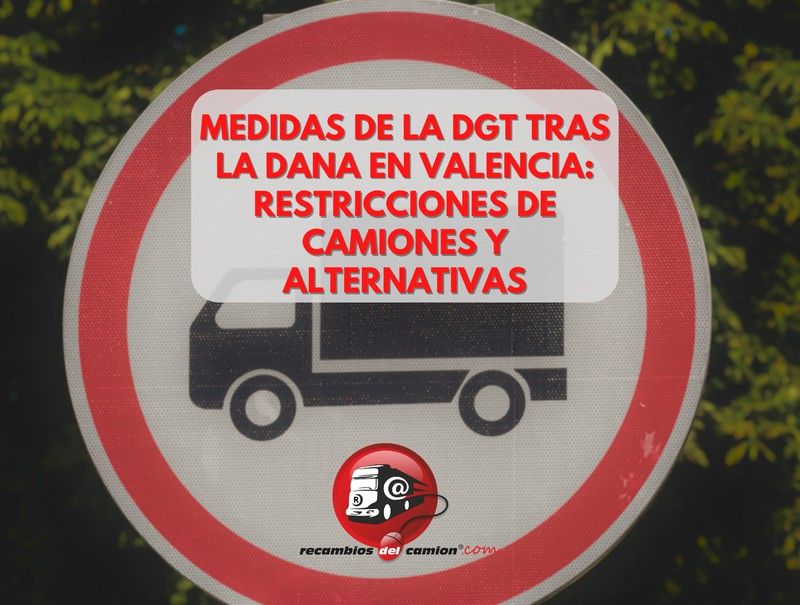Traffic restrictions for trucks in Valencia: Measures, alternative routes, and recommendations for transporters
The recent DANA (High Voltage Accident) in the Valencian Community has had devastating effects on infrastructure and led to unprecedented traffic restrictions in the Valencia metropolitan area. The collapse of a section of the A-7 motorway has severely impacted vehicle mobility, especially freight transport vehicles. In response to the emergency, the Directorate General of Traffic (DGT) has implemented measures to limit the circulation of trucks weighing more than 7,500 kg on key routes in Valencia, allowing only nighttime traffic to reduce congestion and facilitate infrastructure repairs. This article details the restrictions, alternative routes, and recommendations to minimize the impact on the logistics sector.

The Isolated High-Level Depression (DANA) generated torrential rains and landslides, which caused the collapse of the A-7 motorway's through structure at kilometer 336.8, near Quart de Poblet. This section is essential for the Valencia Bypass, the ring road that connects long-distance traffic along the Mediterranean corridor. With more than 77,000 vehicles using this road daily (25% of which are heavy goods vehicles), the infrastructure was severely compromised, affecting not only transport in Valencia but also areas of the port, which receives around 5,000 incoming and outgoing trucks daily.
The DGT has implemented specific restrictions to reduce the flow of large-tonnage trucks in the metropolitan area of Valencia, limiting the circulation of those that exceed 7,500 kg maximum authorized mass (MMA). The measure applies to both loaded and empty trucks, seeking to alleviate traffic and guarantee safety in critical sections while repairs are being carried out.
Restricted hours and routes
For trucks originating or destined for the city of Valencia or its metropolitan area, circulation has been restricted during daytime hours from Monday to Friday, excluding holidays. These vehicles will only be able to circulate between 10:00 p.m. and 7:00 a.m.
The restrictions specifically affect the following sections:
- A-3: From Riba-Roja (kilometer point 339) to Valencia (kilometer point 352), only in the direction of the city.
- V-30: From the Port of Valencia (kilometer point 0) to Paterna-Manises (kilometer point 16), in both directions.
- V-31: From Silla (kilometer point 0) to Valencia (kilometer point 13), in both directions.
- A-7: From Picassent (kilometer point 355) to Riba-Roja (kilometer point 337), in the direction of Barcelona.
The measure came into effect on November 4 and will remain in effect until the Ministry of Transport enable a temporary three-lane detour on the A-7, at its connection with the A-3.
To ensure the supply of essential goods, the DGT has exempted vehicles transporting essential products from these restrictions. This includes trucks transporting perishable food, medicines, and other basic goods. Emergency services, such as ambulances, firefighters, and rescue vehicles, are also allowed to operate freely on restricted routes.
These exceptions guarantee the supply of critical products and the rapid mobility of essential services for the population of Valencia and its surrounding areas.
For long-haul trucks crossing the Mediterranean corridor without destination in Valencia, the DGT has defined alternative routes to avoid congestion in the metropolitan area and reduce traffic in the affected areas:
North-South Axis:
- Aragon and Catalonia: Diversion via the AP-2 / A-2 towards Madrid, instead of the AP-7. In the town of Sagunto, trucks must detour onto the A-23 to continue towards Zaragoza.
- Madrid and Castilla-La Mancha: Alternative via the A-31 and A-30 routes towards Albacete, Alicante, Murcia and Almería.
South-North Axis:
- Andalusia and the Region of Murcia: Alternative via the AP-7 / A-7 towards Albacete, taking the A-31 and the A-3 towards Madrid.
- In Picassent, trucks must detour onto the A-7 to avoid traffic in Valencia.
These alternative routes allow long-haul haulers to reduce congestion in restricted areas of Valencia and minimize the impact on their delivery times.
The DGT has also called on citizens of Valencia and surrounding areas to avoid traveling by private vehicle as much as possible. It is recommended to use public transport, carpooling, and teleworking to reduce pressure on the road network and facilitate the movement of emergency services and the transport of essential goods.
Over the past long weekend, the DGT recorded a reduction in traffic of up to 50%, which has facilitated the movement of priority services. Maintaining this trend in the coming days is crucial to avoid congestion on the roads.
Traffic restrictions for trucks in Valencia represent an exceptional measure to manage the effects of the DANA and protect road infrastructure. Although these restrictions pose a challenge for the logistics sector, they are necessary to facilitate repair work and ensure safety on the affected routes.
For transporters and logistics companies, it is essential to adapt to the restrictions by implementing alternative routes, reorganizing delivery schedules, and prioritizing communication with customers and recipients. With the collaboration of citizens and transporters, the DGT hopes to gradually restore normality to the Valencia transport network.





Opinions of our clients
Receive our news